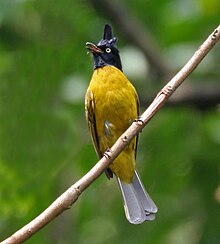Black-crested bulbul
| Black-crested bulbul | |
|---|---|
 | |
Buxa Tiger Reserve in West Bengal, India. | |
Conservation status | |
 Least Concern (IUCN 3.1)[1] | |
Scientific classification | |
| Kingdom: | Animalia |
| Phylum: | Chordata |
| Class: | Aves |
| Order: | Passeriformes |
| Family: | Pycnonotidae |
| Genus: | Pycnonotus |
| Species: | P. flaviventris |
Binomial name | |
Pycnonotus flaviventris (Tickell, 1833) | |
Synonyms | |
| |

Kaeng Krachan Nat’l Park - Thailand
The black-crested bulbul (Pycnonotus flaviventris) is a member of the bulbul family of passerine birds. It is found from the Indian subcontinent to southeast Asia.
Contents
1 Taxonomy and systematics
1.1 Subspecies
2 Description
3 Distribution and habitat
4 Behaviour and ecology
5 References
Taxonomy and systematics
The black-crested bulbul was originally described in the genus Vanga. Until 2008, the black-crested bulbul was considered as conspecific with the black-capped, ruby-throated, flame-throated and Bornean bulbuls.[2]
Subspecies
Eight subspecies are recognized:[3]
Black-crested yellow bulbul (P. f. flaviventris) - (Tickell, 1833): Found from Nepal, northern and eastern India to southern China and central Myanmar
P. f. vantynei - Deignan, 1948: Found from eastern and southern Myanmar to southern China and northern Indochina
P. f. xanthops - Deignan, 1948: Found in south-eastern Myanmar and western Thailand
P. f. auratus - Deignan, 1948: Found in north-eastern Thailand and western Laos
P. f. johnsoni - (Gyldenstolpe, 1913): Originally described as a separate species. Found in central and south-eastern Thailand, southern Indochina
P. f. elbeli - Deignan, 1954: Found on islands off south-eastern Thailand
P. f. negatus - Deignan, 1954: Found in southern Myanmar and south-western Thailand
P. f. caecilii - Deignan, 1948: Found on the northern Malay Peninsula
Description
The black-crested bulbul is generally about 19 cm in length. As the name suggests, the head of this bulbul is black while the rest of its body is different shades of yellow. Both the male and female are similar in plumage. One can make out a younger bird by its slightly duller coloring.
Distribution and habitat
This is a bird of forest and dense scrub.
Behaviour and ecology
It builds its nest in a bush; two to four eggs is a typical clutch. The black-crested bulbul feeds on fruit and insects.
References
| Wikimedia Commons has media related to Pycnonotus flaviventris. |
^ BirdLife International (2016). "Pycnonotus flaviventris". The IUCN Red List of Threatened Species. IUCN. 2016: e.T103826151A104338610. doi:10.2305/IUCN.UK.2016-3.RLTS.T103826151A104338610.en. Retrieved 13 January 2018..mw-parser-output cite.citation{font-style:inherit}.mw-parser-output .citation q{quotes:"""""""'""'"}.mw-parser-output .citation .cs1-lock-free a{background:url("//upload.wikimedia.org/wikipedia/commons/thumb/6/65/Lock-green.svg/9px-Lock-green.svg.png")no-repeat;background-position:right .1em center}.mw-parser-output .citation .cs1-lock-limited a,.mw-parser-output .citation .cs1-lock-registration a{background:url("//upload.wikimedia.org/wikipedia/commons/thumb/d/d6/Lock-gray-alt-2.svg/9px-Lock-gray-alt-2.svg.png")no-repeat;background-position:right .1em center}.mw-parser-output .citation .cs1-lock-subscription a{background:url("//upload.wikimedia.org/wikipedia/commons/thumb/a/aa/Lock-red-alt-2.svg/9px-Lock-red-alt-2.svg.png")no-repeat;background-position:right .1em center}.mw-parser-output .cs1-subscription,.mw-parser-output .cs1-registration{color:#555}.mw-parser-output .cs1-subscription span,.mw-parser-output .cs1-registration span{border-bottom:1px dotted;cursor:help}.mw-parser-output .cs1-ws-icon a{background:url("//upload.wikimedia.org/wikipedia/commons/thumb/4/4c/Wikisource-logo.svg/12px-Wikisource-logo.svg.png")no-repeat;background-position:right .1em center}.mw-parser-output code.cs1-code{color:inherit;background:inherit;border:inherit;padding:inherit}.mw-parser-output .cs1-hidden-error{display:none;font-size:100%}.mw-parser-output .cs1-visible-error{font-size:100%}.mw-parser-output .cs1-maint{display:none;color:#33aa33;margin-left:0.3em}.mw-parser-output .cs1-subscription,.mw-parser-output .cs1-registration,.mw-parser-output .cs1-format{font-size:95%}.mw-parser-output .cs1-kern-left,.mw-parser-output .cs1-kern-wl-left{padding-left:0.2em}.mw-parser-output .cs1-kern-right,.mw-parser-output .cs1-kern-wl-right{padding-right:0.2em}
^ "Species Version 1 « IOC World Bird List". www.worldbirdnames.org. Retrieved 2017-03-11.
^ "Bulbuls « IOC World Bird List". www.worldbirdnames.org. Retrieved 2017-03-12.
Birds of India by Grimmett, Inskipp and Inskipp,
ISBN 0-691-04910-6
- Rasmussen, P.C., and J.C. Anderton (2005). Birds of South Asia. The Ripley Guide. Volume 2: Attributes and Status. Smithsonian Institution and Lynx Edicions, Washington D.C. and Barcelona.
This Pycnonotidae-related article is a stub. You can help Wikipedia by expanding it. |